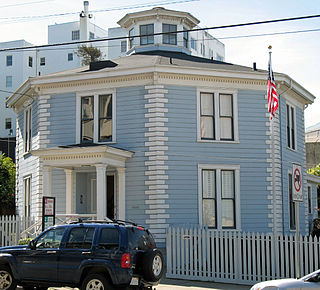
Octagon houses were a unique house style briefly popular in the 1850s in the United States and Canada. They are characterised by an octagonal (eight-sided) plan, and often feature a flat roof and a veranda all round. Their unusual shape and appearance, quite different from the ornate pitched-roof houses typical of the period, can generally be traced to the influence of one man, amateur architect and lifestyle pundit Orson Squire Fowler. Although there are other octagonal houses worldwide, the term octagon house usually refers specifically to octagonal houses built in North America during this period, and up to the early 1900s.

The Middletown Alms House is a historic building at 53 Warwick Street in Middletown, Connecticut, constructed in 1813-1814. It was originally used as a poorhouse and is the oldest surviving building built for housing the poor in Connecticut, as well as one of the oldest such in the United States. One of the largest structures of the Federal period in Middletown, it was listed on the National Register of Historic Places in 1982.
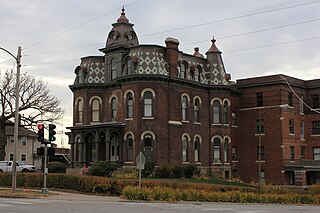
The Joel N. Cornish House is located in South Omaha, Nebraska. The 1886 construction is considered an "excellent example of the French Second Empire style." The house was converted into apartments after the Cornish family moved out in 1911.

Courthouse and Lawyers' Row is a National Historic Landmark District in the center of Clinton, Louisiana. Encompassing the individually listed East Feliciana Parish Courthouse and a series of five law office buildings located 12216 to 12230 Woodville Road, it represents a unique assemblage of law-related high quality Greek Revival buildings. It was added to the National Register of Historic Places and declared a National Historic Landmark on May 30, 1974.

The John Rider House is located on Main Street in Danbury, Connecticut, United States. It is a wooden frame house dating to the late 18th century.

The Octagon House, also known as May's Folly, is a historic octagon house at 527 1st Avenue in Columbus, Georgia. Built about 1830 and enlarged in 1863, it is claimed by the local historical society to be the nation's only known example of a double-octagon house. It was declared a National Historic Landmark in 1973.
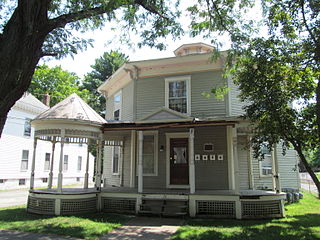
The Octagon House is an historic octagonal house located at 28 King Street in Westfield, Massachusetts. It was built sometime between 1858 and 1864 by Joseph Watson, and is the only one of three 19th-century octagon houses built in the city to survive. The house was listed on the National Register of Historic Places in 1982, and included as part of expansion of the Westfield Center Historic District in 2013.
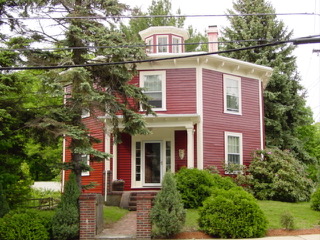
The William Bryant Octagon House is an historic octagon house located at 2 Spring Street in Stoneham, Massachusetts. Built in 1850, it is the best-preserved of three such houses built in the town in the 1850s. It was listed on the National Register of Historic Places in 1984.
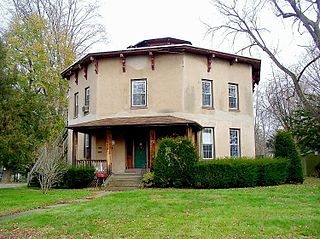
The Joseph Williams Octagon House and the Gilbert Stancliff Octagon House are once-identical historic mid-1850s octagon houses located next to each other at 26 and 28 Marlborough Street in Portland, Connecticut. Constructed of Portland brownstone in the 1850s, they are distinctive as the only known pair of little-altered octagon houses in the state. The pair of houses, also known as the Octagon House Pair, was added to the National Register of Historic Places in 1976.

The Estabrook Octagon House, built in 1853 by Ezra Robinson Estabrook, is a historic octagonal house located at 8 River Street in Hoosick Falls, New York. It was constructed in strict accordance with the theories of Orson Squire Fowler, author of A Home for All.

The Capt. Rodney J. Baxter House is an historic octagonal house at South and Pearl Streets in Barnstable, Massachusetts. Built in 1850, it is Barnstable's only example of an octagon house, built closely to designs advocated by Orson S. Fowler and briefly popular in the 1850s. It was listed on the National Register of Historic Places in 1987.

The Centre Village Meeting House is a historic meeting house (church) on New Hampshire Route 4A in Enfield Center, New Hampshire. Built in 1836, it is a well-preserved late example of Federal period church architecture, albeit with some Greek Revival stylistic elements. Then as now, it serves as a nondenominational building, serving a variety of small Christian congregations. The building was listed on the National Register of Historic Places in 1985.

The New London County Courthouse is a historic courthouse located at 70 Huntington Street at the top of State Street in New London, Connecticut. It was built in 1784–86, and its design is attributed to Isaac Fitch. It is the oldest courthouse in Connecticut according to a plaque on the building, and the State of Connecticut Superior Court sits there. It was added to the National Register of Historic Places in 1970.

Hearthstone Castle in Danbury, Connecticut, was built between 1895 and 1899. It was listed on the National Register of Historic Places in 1987. It has also been known as Parks' Castle and as The Castle. The property includes four contributing buildings and three other contributing structures. Today, the castle is owned by the City of Danbury and is located in Tarrywile Park. Hearthstone Castle is slated to be renovated into an observation deck.
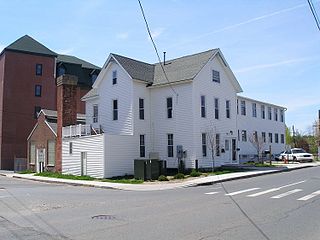
The Ball and Roller Bearing Company, also known as American Family Crafts and the Joseph Nutt House and Machine Shop, is a historic industrial complex at 20-22 Maple Avenue in Danbury, Connecticut. Developed mainly in the early 20th century, the factory is most notable as the location where Lewis Heim invented the modern grinding machine, which revolutionized the manufacture of machine parts. The complex was listed on the National Register of Historic Places on August 25, 1989. It now houses a church and social service agencies.

The Alternative Center for Excellence (ACE), formerly the Alternative Center for Education, is located in the former Locust Avenue School at 26 Locust Avenue in Danbury, Connecticut, United States. It is an alternative high school within Danbury Public Schools, meant for at-risk students.

The Hurlbutt Street School is a historic one-room schoolhouse at 157 Hurlbutt Street in Wilton, Connecticut. Built in 1834, it served the town as a school for nearly a century, and was then converted to a local history museum. It is the town's best-preserved 19th-century district school building, and was listed on the National Register of Historic Places in 1996.

The Charles Ives House, also known as Charles Ives Birthplace, is located on Mountainville Avenue in Danbury, Connecticut, United States. It is a wooden frame structure built in 1780 and expanded on since. Over the course of the 19th century it was the residence of several generations of Iveses, a family important in the city's history. In 1874 it was the birthplace of Charles Ives, who became an internationally recognized composer in the early 20th century.
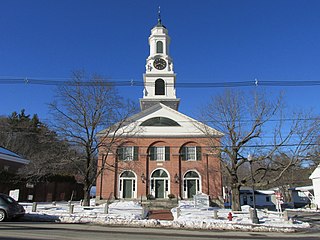
The Peterborough Unitarian Church, also once known as the First Church in Peterborough, is a historic American church at Main and Summer streets in Peterborough, New Hampshire. Built in 1825-26 for a congregation founded in 1752, it is one of the state's finest examples of a Federal period church, drawing inspiration from the publications of Asher Benjamin. The building was listed on the National Register of Historic Places in 1973.

The Calvin Day House is a historic house at 105 Spring Street in Hartford, Connecticut. Built in 1852, it is the last survivor of a series of fine Italianate houses that lined a bluff overlooking Hartford's Union Station. It was listed on the National Register of Historic Places in 1978. It now houses a social service agency.

























